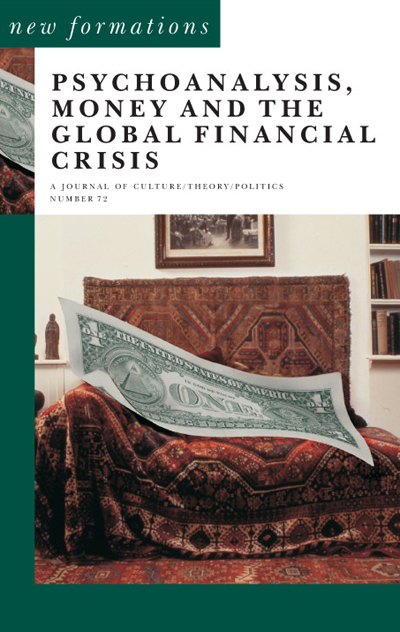
What a waste of money: expenditure, the death drive and the contemporary art market
New Formations - Print ISSN 0950-2378 - Online ISSN 1741-0789
Volume 2010 Number 72
What a waste of money: expenditure, the death drive and the contemporary art market
Paul Crosthwaite
Abstract
The commonplace, knee-jerk response to the enormous sums realised by iconic works of postwar and contemporary art - ‘what a waste of money!’ - is conventionally countered in three ways: by explaining that such pieces possess an aesthetic importance that fully justifies the amounts spent to acquire them; by, conversely, making the pragmatic point that artworks can often prove to be extraordinarily lucrative investments; or, in a synthesis of these polarised views, by arguing that collecting art yields a degree of ‘symbolic capital’ (evidence of one’s knowledge, taste and sophistication; access to an exclusive, glamorous and creative social milieu) for which many are understandably willing to pay a premium. In this essay, however, I argue that the philistine and reactionary standpoint typically occupied by those who denounce money spent on contemporary art as money ‘wasted’ should not blind cultural critics to the kernel of truth in such assertions: that it is precisely the function of the contemporary art market - and of the art auction in particular - to provide an arena in which reserves of capital may be wantonly expended, and that the wastefulness of such acts of prodigality is maximised when the object purchased itself represents, or literally embodies, waste - hence the prominence today of artworks that entail death, decay, mortification and abjection. In articulating this position, I draw on a theoretical tradition that has its roots in the Freudian theory of the death drive and runs through the work of the French thinkers Georges Bataille, Jean Baudrillard and Julia Kristeva. I pay particular attention to the auction of work by the ‘Young British Artist’ Damien Hirst at Sotheby’s in London in September 2008, a carnival of expenditure that partook of the wider zeitgeist of financial dissipation generated by the global ‘credit crunch’, then entering its most intense phase.
SORRY - you are not registered as being permitted online access to the full text of this article
You have the following options:
- If you are viewing this via an institution or academic library you can ask that your institution takes out a Subscription to this journal.
- If you already have a Personal Subscription please login below
Forgotten your username / password? Click here to locate
- Purchase an annual Personal Subscription
PRINT + DIGITAL personal subscription (£45 / year)
DIGITAL personal subscription (£30 / year)
A Personal Subscription provides immediate access not only to the single article you are seeking, but also to all past and future articles in this journal up to the expiry of your annual (calendar year) subscription. - Purchase immediate access to this single article (UK£7.00) - Buy article Coming Soon
To cite this article
Paul Crosthwaite (2010) What a waste of money: expenditure, the death drive and the contemporary art market, New Formations, 2010(72)
